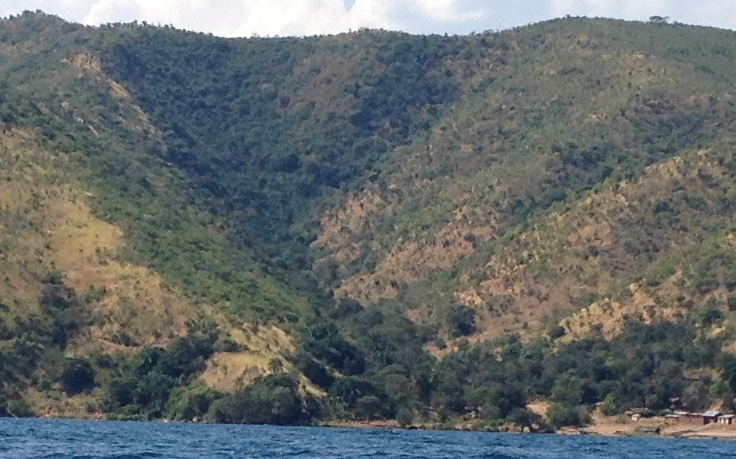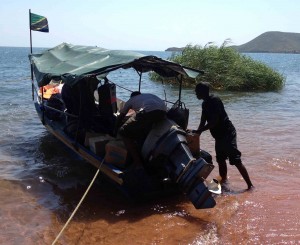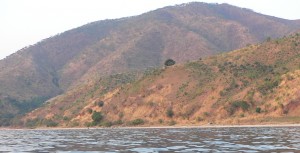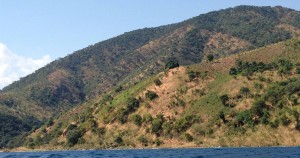04 June 2014
Gombe National Park is pretty remote. It is in the northwest corner of Tanzania, on the shores of the world’s longest and second deepest lake, Tanganyika. From the lakeshore at Gombe, you can see the hills of Burundi to the north and the mountains of Congo across the lake. It took me several days of travel, by train, plane and boat, to get to Gombe from our current home in France.
The research station at Gombe is only 22 km (14 miles) north of town, but because Gombe is surrounded by steep hills, you can’t drive there. Instead, we travel by boat, which usually takes 1.5 to 2 hours, depending on the conditions of the lake. The lake is often calm in the morning, but as the air heats up in the afternoon the lake gets choppier, until early evening when (usually) it starts to calm down again. We left town at 2:00 pm, with a heavily laden boat and rough water.
Having been away for two years, the biggest change I noticed was on the hills above the lakeshore villages. When I first visited Gombe in 2001, the hills outside the park were bare. Fields of cassava and beans were planted on slopes that seemed much too steep for agriculture. Red earth showed from erosion scars, including one in Mtanga village where a landslide in January 2001 killed 13 people.
Here’s a picture of Kazinga village, right at the southern boundary of the park, in August, 2005:
The park boundary runs along the crest of the hill, and apart from one big green mango on the ridge in the foreground, the trees end at the park. Just about everything on the slopes outside the park has been cut for firewood.
In contrast, here’s how the same ridge looks now. It’s early dry season so the grass is greener, and thus makes the contrast seem even starker. But even taking this into account, what surprised me was seeing lots of trees on the slopes outside the park. Where the forest used to end abruptly at the park border, now a blanket of forest drapes over the ridge, extending down towards the village. There aren’t trees everywhere, but even in Gombe the forest cover is intermixed with woodlands and grasslands, depending on the terrain and soil conditions. But that there are any noticeable trees at all outside the park is striking. The Jane Goodall Institute’s reforestation project really seems to be working.
It wasn’t just Kazinga village, either. Passing by many of the lakeshore villages I was struck at the contrast: steep hills were now blanketed in green trees instead of bare red earth. The photo at the top of this blog post is Kigalye village, which has an especially extensive forest reserve. The trees are coming back.
After I got to Gombe, Lilian Pintea showed me satellite images that confirmed what I had seen from the lake. Not just along the lakeshore, but extending all along the crest of the rift escarpment, trees were coming back. This was the interconnected network of village forest reserves that had been promised in the Greater Gombe Ecoystem project. It really is happening.
The deforestation of the village hills was a classic Tragedy of the Commons. The trees provide many public goods. Their roots hold the soil in place, preventing erosion and landslides and protecting the watershed so important for the streams, the main source of drinking water for the villages. The trees provide wood for cooking fires, furniture, boats, musical instruments and traditional carvings. Many of the trees produce fruit eaten not only by animals such as chimpanzees and baboons, but also by people. Their flowers enable bees to make honey. The leaves of the trees shade the ground, slowing evaporation, helping the soil retain moisture. But because the trees are common property of the village, as the human population grew, people cut the trees faster than they could grow back. Soon the villages suffered the public costs of deforestation: erosion, landslides, fouled drinking water, lack of wood for fuel and lumber, and the disappearance of plants valued for traditional medicine.
In 1994, the Jane Goodall Institute started the Lake Tanganyika Catchment Reforestation and Education Program (TACARE). Twenty years later, with help from many outside sources, including the Nature Conservancy and USAID, the project really does seem to be succeeding.
Will the project be a success in the long term? That really depends on the people living in the villages, and whether, as the years go by, they perceive the forests as providing net benefits to them. There will undoubtedly be cases of human-wildlife conflict. Animals living in the forest reserves may raid crops; and people might hunt the animals. As trees grow bigger, there will be strong temptations to cut the trees with valuable timber, and decisions will need to be made at the village level about how to manage these resources effectively. But seeing these trees growing has given me hope that these are solvable problems.



